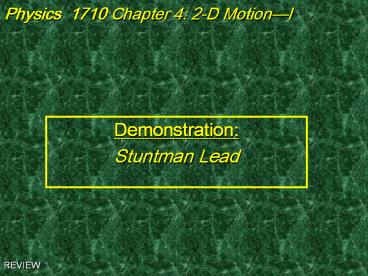Demonstration: - PowerPoint PPT Presentation
Title:
Demonstration:
Description:
Physics 1710 Chapter 4: 2-D Motion I. No lead. t = (2h/g) d = vtruck t ... Projectiles follow a parabola [y(x) = A Bx Cx2] Physics 1710 Chapter 4: 2-D Motion II ... – PowerPoint PPT presentation
Number of Views:30
Avg rating:3.0/5.0
Title: Demonstration:
1
Physics 1710 Chapter 4 2-D MotionI
0
- Demonstration
- Stuntman Lead
REVIEW
2
Physics 1710 Chapter 4 2-D MotionI
0
- Demonstration Stuntman Lead
No lead
REVIEW
3
Physics 1710 Chapter 4 2-D MotionI
0
- Demonstration Stuntman Lead
Proper lead d vtruck v(2h/g) d (15 m/s)v2
(3.15 m)/9.8 m/s2) d 12.0 m
REVIEW
4
Physics 1710 Chapter 4 2-D MotionI
0
- 1' Lecture
- Displacement, velocity and acceleration are
vector quantities in two or more dimensions. - Each component of the kinematic variables
- is separate and independent.
- In projectile motion the x-motion is
unaccelerated while the y-motion experiences a
constant acceleration equal to -g.
5
Physics 1710 Chapter 4 2-D MotionI
0
- Position r is a vector.
- r x i y j
- Or rx x ry y
- Thus, one can represent a vector by a position
vector, ie an arrow.
6
Physics 1710 Chapter 4 2-D MotionI
0
- Displacement in 2-D is a vector
- ? r r final - r initial
- ? rx x final - x initial ?x
- ? ry yfinal - y initial ?y
- ? r ?? r?
- ?? r? v(x final - x initial ) 2 (yfinal - y
initial) 2 - Tan ? (yfinal - y initial)/ (x final - x
initial )
7
Physics 1710 Chapter 4 2-D MotionI
0
- Average velocity is a vector
- vave ? r / ?t
- This means the following
- vx, ave ? x / ?t
- vy, ave ? y / ?t .
y(x) trajectory
y(t)
y
x
x(t)
t
8
Physics 1710 Chapter 4 2-D MotionI
0
- Average velocity is a vector
vy, ave ? y / ?t
y(x) trajectory
y(t)
y
x
x(t)
vx, ave ? x / ?t
t
9
Physics 1710 Chapter 4 2-D MotionI
0
- Instantaneous velocity is a vector
- v lim ?t ? 0 ? r / ?t
- This means the following
- vx lim ?t ? 0 ? x / ?t dx /dt
- vy lim ?t ? 0 ? y / ?t dy/dt
10
Physics 1710 Chapter 4 2-D MotionI
0
- Instantaneous velocity is a vector
y
x
t
11
Physics 1710 Chapter 4 2-D MotionI
0
- Average acceleration is a vector
- aave ? v / ?t
- This means the following
- ax, ave ?vx / ?t
- ay, ave ?vy / ?t .
12
Physics 1710 Chapter 4 2-D MotionI
0
- Instantaneous acceleration is a vector
- a lim ?t ? 0 ? v / ?t
- This means the following
- ax lim ?t ? 0 ? vx / ?t dvx /dt
- ay lim ?t ? 0 ? vy / ?t dvy /dt
- N.B.
- The components are strictly segregated!
13
Physics 1710 Chapter 4 2-D MotionI
0
- Motion in Two Dimensions
- All the one dimensional kinematic equations can
be generalized to two (or more) dimensions. - All the component equations obey the one
dimensional kinematics separately.
14
Physics 1710 Chapter 4 3-D MotionI
0
- Two two balls are simultaneously shot
horizontally and dropped,which will the ground
first? Why?
REVIEW
15
Physics 1710 Chapter 4 2-D MotionI
0
- Vector kinematic equations (uniform a)
- rfinal rinitial vinitial t ½ a t 2
- vfinal vinitial a t
16
Physics 1710 Chapter 4 2-D MotionI
0
- Projectile Motion
- Horizontal acceleration
- ax 0
- ? vx, final vx, initial
- xfinal x initial vx, initial t .
- Vertical acceleration
- ay -g
- ? vy, final vy, initial - g t
- yfinal y initial vy, initial t - ½ g t 2
17
Physics 1710 Chapter 4 2-D MotionII
0
- Summary
- Kinematics in two (or more) dimensions obeys the
same 1- D equations in each component
independently. - rfinal rinitial vinitial t ½ a t 2
- vfinal vinitial a t
- vx,final2 vx,initial 2 2 ax /?x
- vy,final2 vy,initial 2 2 ay /?y
- Projectiles follow a parabola y(x) A Bx
Cx2































